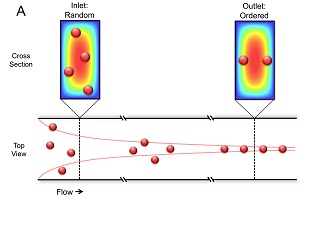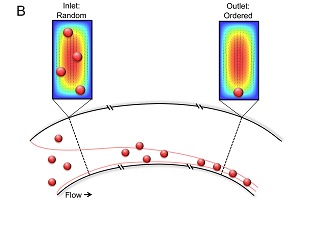
Suppose we have a rectangular microchannel containing a laminar flow with Reynolds number Re = 1. Next, let’s randomly distribute suspended particles at the channel’s inlet. Given that there are no external forces acting on these particles, you would intuitively expect that the particles would trace the fluid streamline. However, scientists from Massachusetts General Hospital (MGH) and Veryst Engineering would disagree, and their research findings suggest a completely different pattern than what would be expected. The researchers claim that depending on the geometry of the flow channel, Dean number, and the particle and channel Reynolds number, the randomly dispersed particles will converge to an equilibrium position that would not be described by the typical flow streamlines.
Applications of Inertial Focusing
The concentration and isolation of cells for further study is important in many medical procedures, as it allows cells to be removed from a sample for analysis and testing. Inertial focusing, or inertial separation, is one such microfluidics technique that can be used to separate different sized particles, allowing them to be removed from a sample and analyzed. In an article fromCOMSOL News 2013, “Modeling Inertial Focusing in Straight and Curved Microfluidic Channels”, the researchers describe the equilibrium positions that will be formed by different sized particles using COMSOL simulations to predict the separation patterns.
The researcher’s findings suggest that the effects of inertial focusing in a straight channel will cause two particle equilibria to form at the center of the long face of the channel cross section, as shown in Figure 1A. Additionally, when a curvature is introduced to the microchannel, the resulting forces applied on the particles will adjust the equilibrium position, as seen in Figure 1B. This phenomenon is characterized by the inertial fluid forces and can have abroad spectrum of applicationsincluding research, industrial, and clinical applications. Recently, this technology played a key role in the design of biomedical devices and was used to detect malignant cancer cells in a blood sample.
 |
 |
Figure 1: Effects of inertial focusing on particles in a straight channel (A), and a curved channel (B).
Understanding the Physics of Inertial Focusing Through Simulation
Understanding of the physics behind the odd behavior exhibited by particles in a laminar flow channel requires the use of complex CFD models. The researchers used COMSOL to predict the equilibrium locations of the particles and the variation of these positions with flow and geometry parameters. They analyzed both a straight channel as well as a curved channel and validated their predictions with experimental results.
To better understand the physics and facilitate the modeling procedure, they divided each model into two steps. First, they computed a CFD model not including the particles, which provided them with a standard Hagen-Poiseuille flow solution for the straight channels, and a Dean flow solution for the curved channels. Then, they mapped the solution from the first step to the inlet boundary condition of a second CFD model with the particles represented as void in the CFD domain. The model also included appropriate moving wall conditions to account for the translation and rotation of the particles. By setting up global differential equations, the researchers calculated the equilibrium of the particles in terms of the linear and angular velocities. Then they calculated the transverse inertial lift forces created by the fluid. Lastly, they added the effect of the Dean flow obtained in the first part of the model assuming a Stokes drag acting on the particles. Finally, with all of the equations in hand, the researchers were able to run the simulation by defining the force as well as the momentum equations and directly visualize the inertial focusing effects for any defined setting of suspended particles.
Further Reading
- Read the full user story: “Modeling Inertial Focusing in Straight and Curved Microfluidic Channels“



Comments (4)
robert wilson
July 4, 2016i think the hyper link in Further Reading is wrong. it openshttp://www.comsol.com/offers/comsolnews13/.
Bridget Cunningham
July 6, 2016 COMSOL EmployeeHi Robert,
Thank you for your comment.
Please find an updated link to the user story included in the Further Reading section.
Best regards,
Bridget
黄 庆
April 8, 2017Is it possible to download the tutorial files? Although I read the introductions, I could no complete the simulations.
Caty Fairclough
April 10, 2017Hello,
Thank you for your interest in this blog post. Unfortunately, this specific example is not available for download. For modeling assistance, please feel free to contact our support team.
Online support center:https://www.comsol.com/support
Email:support@comsol.com
Best,
Caty